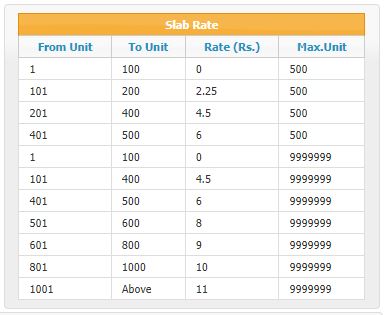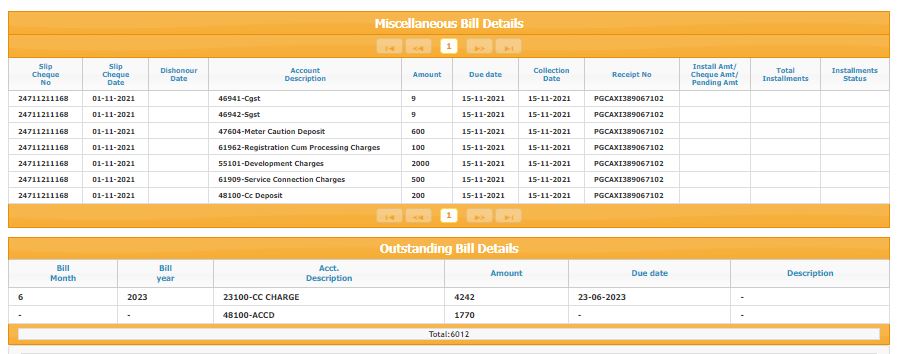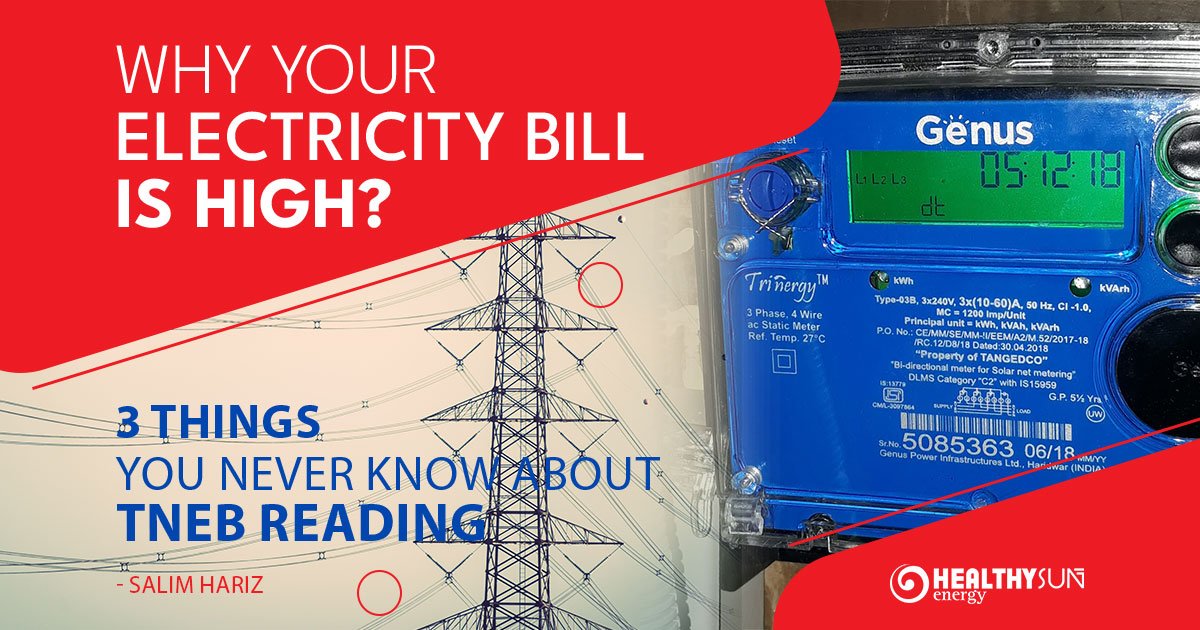As a consumer, we never think deeply about TNEB Reading but are just worried about the high electricity bill generated. People ignore a few things that can be easily avoided that cause an unwanted hike in monthly EB expenses.
TANGEDCO increased the electricity prices in 2022 after many years and introduced a new slab system for residential customers. The consumers get pretty much an increase in bills to the same amount of units consumed compared to prior price hikes.
Apart from these increased tariffs, there are some unknown charges added to the electricity bills periodically. We tell about those key unknown parameters that can save you a lot of money and some unwanted issues with EB.
How TNEB Reading is taken?
In most of the premises, the TNEB reading is taken as bi-monthly. For HT (High Tension) line consumers like industries and factories, the consumption is calculated monthly.
This article covers mostly the residential consumers who suffer mostly from increased electricity bills which are only expenses.
How TNEB reading is calculated?
The field person takes the Digital EB meter reading for each connection and calculates the total amount payable as per the new slab of tariffs. These readings and calculations are fed into the TNEB online portal and data is available for consumers to see and pay online directly. Apart from this portal, TNEB has multiple options like UPI, etc to pay the bills.


Even though many people have access to this online portal, most of them skip the details and just use it to pay the bill. The case in rural and suburban areas is even worse. They still don’t access this portal and just pay the amount written on their EB card.
This is where many of us miss the details which sometimes cause unwanted and unexpected expenses.
Revised EB Tariff from TANGEDCO for different consumers
Overall the power consumption charges per unit have been increased for all consumers. One of the important introductions is the conversion of Common facilities in Multitenements to a new tariff of I-D which is a flat 8 Rs per unit. “First 100 units of FREE Current” does not apply to this tariff even though it is for residential consumers.

Another major hike for the residential customer is the consumption above 1000 units in a bi-monthly cycle. One of our customers for consuming 1900 units in 2022 was 10,000/- approximately, for the same consumption in the new tariff he is paying 17,500/- approximately now.
| For a complete understanding of the current tariff structure, read it here |
How to use the TNEB Online Payment Portal?

Here is the TNEB online payment portal. If you are a new user to this portal, create a new user account with your EB service number and email. You can also add 15 other services numbers to monitor and pay the eb bills.
Once you register with the TNEB Online Payment portal (TANGEDCO), you can view all your details regarding your EB service connection, reading, current tariff, monthly readings, etc.
The Account Summary section has all the details for a consumer.
How does TNEB online payment work?
Logged-in customers can see if any bill is generated on the first dashboard itself. They can select the pay bill option and pay the bill amount through their payment gateway via credit card, net banking, UPI, etc.
What are the 3 important things you should notice on the TNEB online payment portal?
Once we log into the TNEB online portal, we usually see the bill details and pay it online. But apart from the bill details, there are a few more sections which we should keep an eye on.
The Three important things that can cause excess EB bills are
- Load (Sanctioned load) & Tariff
- Meter Change Details
- Miscellaneous Bill Details
1. Load (Sanctioned Load) & Tariff:
For each meter connection from TANGEDCO, they provide a sanctioned load in capacity. For a single-phase residential connection, the maximum sanctioned load is 3kw which means the consumer can use a maximum load of 3000w at a time.
But by default the sanctioned load for a single-phase meter is 1kw and the default load for a 3-phase residential meter is 4kw.
For commercial and industrial lines like HT, the sanctioned load will be higher like 30kw, 110KW, etc.
How is this sanctioned load/demand load fixed for a connection?
This is estimated based on the appliances going to be connected to the GRID and their wattage.
For Example: In a residential single-phase connection, the total wattage of the appliances like lights, fans, TV, washing machine, etc wouldn’t cross more than 3KW at a time. This is very common and the demand load is fixed in this estimation by default.
Another scenario of wrong information entered:
A couple of our customers faced an issue when they applied for Solar Netmeter in TNEB. The connection they had then was a 3-phase line but the TNEB online portal showed it as a single-phase connection with a 2KW demand load.
When investigated further, we found that both customers initially had a single-phase connection and later changed to a 3 phase line. However, after the connection change, these details were not updated on the TNEB Portal. We again approached the local EB with a requisition and updated the right information before applying for a Solar Net meter.
What happens if the electricity usage exceeds your sanctioned load?
A very important thing to understand in this Sanctioned Load is, that our maximum consumption at a time should not exceed the Sanctioned load, If this crosses very often, then it creates chances to receive additional charges in your EB Bill.
This additional fees is called “demand charges” or “Power factor penalty”
If this is not corrected immediately, then paying additional charges in electricity bills continues. For Commercial consumers these charges are very high. When there is a problem caused by a door being closed or a metre malfunction, the EB will require you to pay the highest EB bill you have paid in the year
How to rectify the sanctioned load issue in TNEB?
If your regular consumption is exceeding the demand load often, you can approach TNEB and increase the demand load to match the consumption wattage. If the current demand load is 4kw for example, we can give a letter or request to the Local TNEB office or do it online through the TANGEDCO online portal here

You can apply online by yourself with the necessary details in the online application form and there will be fees for this increasing process which are directly payable at the TANGEDCO portal online.
If the additional KW required is minimal like 1kw or 2kw, the charges will be minimal and if the demanded additional load is higher like 5kw or more, then the charges will be higher as there will be a requirement of laying new cable from the EB side to handle more electricity flow.
Check the tariff:
Each consumer is given a tariff under which the EB bill amount is calculated against the units consumed. Check if your tariff is rightly mentioned. Sometimes by mistake, the tariff would be wrongly updated and you would be paying either excess or less.
There is a classic example of this. One new customer approached us regarding high electricity bills. It was a newly constructed house and the temporary connect tariff was not changed to the residential tariff. A building under construction will get a temporary tariff and It will be changed to the designated tariff once the building is occupied.
Why TNEB bill is high this month?
Many TNEB customers are billed with additional charges in the May month TNEB Reading and these charges are made in the name of ACCD (Additional Current Consumption Deposit).
A security deposit is an amount calculated for each connection and collected as a refundable one. This is revised once in two years for LT connections and every year for HT connections. This security deposit is a backup for the TNEB if the consumer fails to pay his EB bills.
This Security Deposit is calculated as 3 times the average EB bill generated in a year.
For example, if the average EB bill generated in a year (6 bills) for a bi-monthly consumer is 2000/- INR, then the security deposit will be 3 x 2000/- which is 6000/-. This security deposit will be refunded by TNEB whenever the consumer surrenders his EB connection
What is ACCD in TNEB reading?
There is a reason that any consumer may install more appliances and increase his consumption. Moreover in those cases, if the security deposit amount calculated exceeds the previously calculated deposit, then ACCD is levied.
So every consumer should look deeper into the TNEB online portal for every bill generated.
2. Meter Change Details
Another section in the TNEB Portal you have to keep an eye on is the “Meter Change” section. This is where you can find the history of the faults your EB meter has encountered if any.
One new customer contacted us and complained about excess EB Bills and was unaware of the reason. They had no new appliances added recently.
When we checked their online portal. It was mentioned that the EB meter was faulty. So they have charged the highest bill the customer has paid before. In addition, this was the case for a few months and the faulty meter was not fixed for some time.
If you suspect the EB meter reading is not accurate, kindly complain against the meter to fix it. Sometimes the EB persons will not inform the consumer about the faulty meter, but they fix and update it on the portal.

3. Miscellaneous Bill Details
The third area on the portal that has to be monitored on the portal the “Miscellaneous Bill Details” and “Outstanding Bill Details” sections. This is where all the additional charges, any other charges, and outstanding bills will be mentioned.
Whenever you receive a high electricity bill, directly visit this section to see if there are any new fees added.

How to avoid additional charges in TNEB Reading and save electricity expenses
- Always check the parameters we have mentioned in the article and take the necessary actions.
- Check the demand load and change it if your regular consumption is increased to avoid ACCD charges.
- Conserve power by cleverly using your appliances and monitoring their performances.
- Rightly use your high-wattage appliances like Air Conditioners to save power consumption.
- Always switch off and unplug unused appliances instead of keeping them on standby.
- Complain and rectify your faulty meter if needed
Conclusion
Simple things can avoid huge expenses if they are monitored properly. When tools like the EB portals are available with a lot of information, use them. Try to install solar panels for your buildings and reduce electricity expenses for 25 years. For residents, even installing a smaller system can help in bringing down the slab rates much lower. The ROI (Return on investment) is good. Many of our solar customers are enjoying the benefits of Solar Power in their buildings.

8 Replies to “3 things you never know about TNEB Reading: Why your electricity bill is high”
Neet And Angel
June 27, 2024
I never knew that TNEB charges penalties for not submitting the consumption data on time. That’s really insightful! It’s amazing how these small details can add up to increase our electricity bills. Thanks for sharing your expertise and shedding light on these hidden charges.
aPkReSuLt
October 28, 2024
This post was super informative! I had no idea about the factors affecting TNEB readings and how they could lead to a higher bill. The explanation of peak hours and energy wastage really opened my eyes. Thanks for shedding light on this!
CAPCUT MOD APK
November 14, 2024
This post really opened my eyes to the factors that can drive up my electricity bill! I had no idea about the impact of seasonal changes and peak usage times. Thanks for the valuable insights!
nulls brawl
December 6, 2024
Great insights! I never realized how much factors like voltage fluctuations and meter errors could impact my bill. Definitely going to keep an eye on those readings now! Thanks for the tips!
Ok win
March 3, 2025
Great insights in this post! I had no idea that factors like voltage fluctuations and the timing of my electricity usage could impact my bill so much. It’s definitely made me reconsider how I manage my electricity consumption. Thanks for sharing these tips!
lottery 7 login
March 28, 2025
This post was really eye-opening! I always thought my bill was high due to usage, but I had no idea about the impact of load variations and incorrect readings. Thanks for breaking it down so clearly!
fortnite app
April 2, 2025
This was such an informative read! I had no idea about the different factors that can contribute to a higher electricity bill. The tip about checking for mistakes in the meter reading is particularly useful. Thanks for shedding light on these aspects of TNEB!
Mp3juices
April 10, 2025
Great insights! I never realized how much factors like appliance usage and peak hours could impact my bill. It’s eye-opening to understand that small changes in behavior could lead to significant savings. Thanks for shedding light on this!